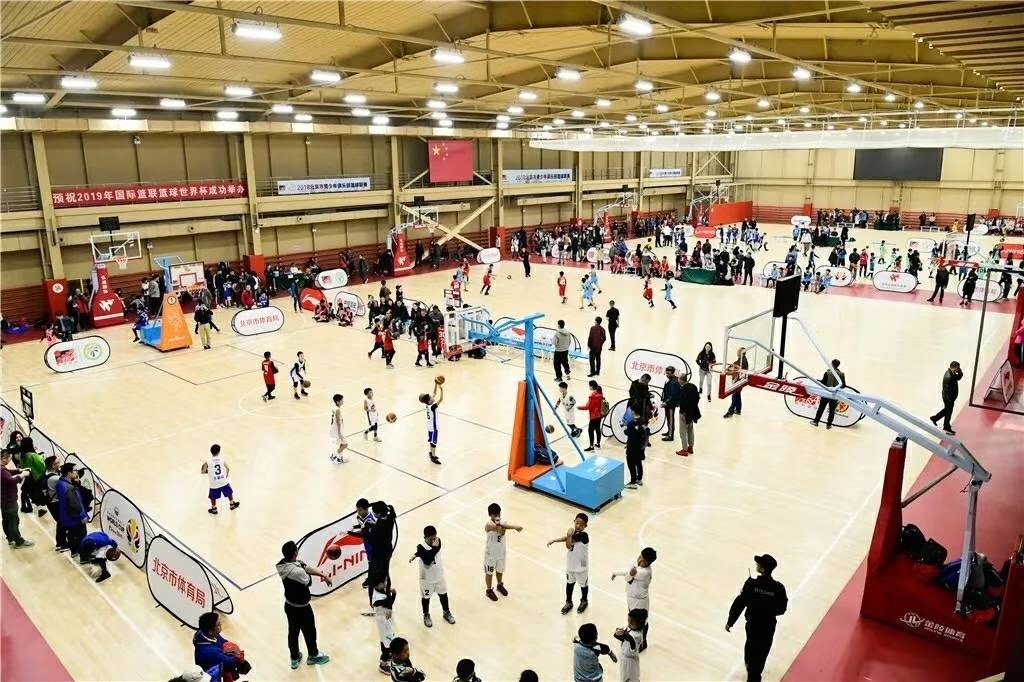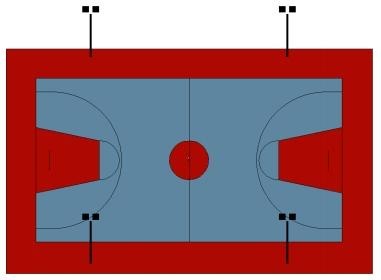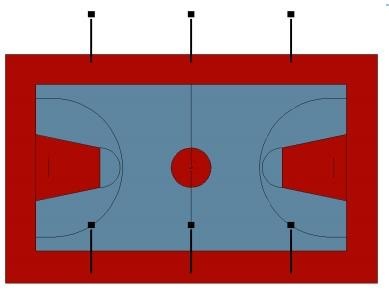Lighting system is complicated but a very important part of stadium design. It not only meets the requirements of players and audiences, but also satisfy the lighting requirements of real-time broadcasting in terms of color temperature, luminance and uniformity, which is more essential than the former. In addition, the light distribution method should be consistent with the overall plan of the stadium, especially the maintenance of lighting equipment should be closely related to the architectural design.
LIGHTING REQUIREMENTS
Lighting standards for indoor basketball court are as below.
| MINIMUM ILLUMINATION LEVELS(interior) | Horizontal illumination E med(lux) |
Uniformity E min/E med |
Lighting class | ||
| FIBA level 1 and 2 international competitions(half to 1.50m above the playing area) | 1500 | 0.7 | Class Ⅰ | ||
| International and national competitions | 750 | 0.7 | Class Ⅰ | ||
| Regional competitions, high level training | 500 | 0.7 | Class Ⅱ | ||
| Local competitions, school and recreational use | 200 | 0.5 | Class Ⅲ | ||
Lighting standards for outdoor basketball court are as below.
| MINIMUM ILLUMINATION LEVELS(interior) | Horizontal illumination E med(lux) |
Uniformity E min/E med |
Lighting class | ||
| International and national competitions | 500 | 0.7 | Class Ⅰ | ||
| Regional competitions, high level training | 200 | 0.6 | Class Ⅱ | ||
| Local competitions, school and recreational use | 75 | 0.5 | Class Ⅲ | ||
Notes:
Class I: It describes the top-class, international or national basketball matches such as NBA, NCAA Tournament and FIBA World Cup. The lighting system should be compatible to broadcasting requirement.
Class II: The example of class II event is regional competition. The lighting standard is less vigorous as it usually involved non-televised events.
Class III: Recreational or training events.
LIGHT SOURCE REQUIREMENTS:
- 1. High installation stadiums should use SCL LED light sources with a small beam angle.
2. Low ceilings, smaller indoor courts should use LED sports lights with lower power and larger beam angles.
3. Special places should use explosion-proof LED stadium lights.
4. The power of the light source should be adapted to the size, installation location and height of the playing field to suit outdoor sports venues. High-power LED stadium lights should be used to ensure uninterrupted operation and fast startup of LED light sources.
5. The light source should have appropriate color temperature, good color rendering index, high light efficiency, long lifespan, stable ignition and photoelectric performance.
Correlated color temperature and the application of the light source is as below.
| Correlated color temperature (K) |
Color table | Stadium application | |||
| ﹤3300 | Warm color | Small training place, informal match place | |||
| 3300-5300 | Intermediate color | Traning place, competition place | |||
| ﹥5300 | Cold color | ||||
INSTALLATION RECOMMENDATION
The location of the lights is critical to comply with the lighting requirements. It must ensure that the lighting requirements can be achieved, while not interfering with the players’ visibility as well as not creating any glare towards the main camera.
When the main camera position has been determined, the sources of glare can be minimized by avoiding the installation of lights in the forbidden area.
Lamps and accessories should be in full compliance with the safety performance requirements of the relevant standards.
The electric shock level of the lamps should meet the following requirements: it should be used with grounded metal work lighting fixtures or class II lamps, and swimming pools and similar places should be used for class III lamps.
Typical mast layout for football fields is as below.
Post time: May-09-2020



